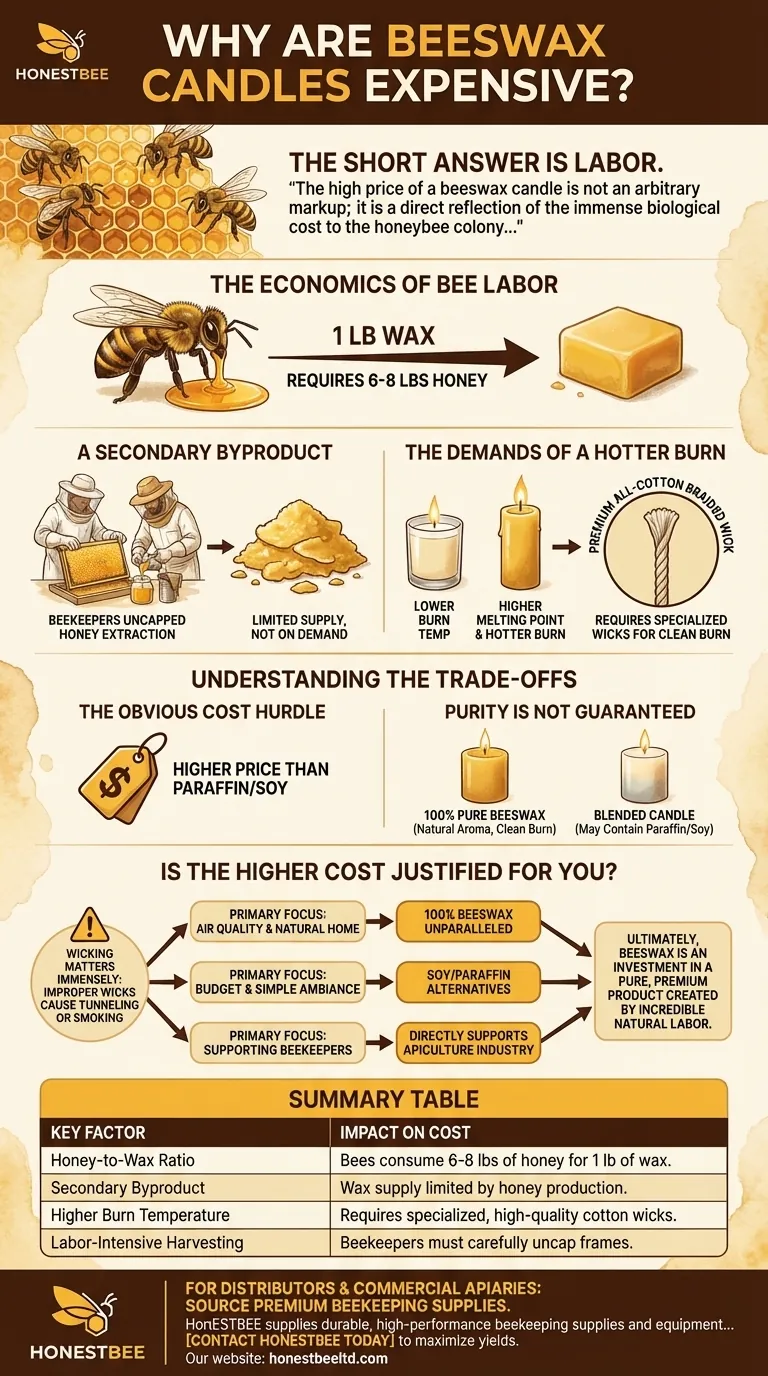The short answer is labor. Beeswax candles are expensive because the raw material, pure beeswax, is incredibly resource-intensive for honeybees to produce. It reflects a tremendous amount of natural work that cannot be cheaply or artificially replicated.
The high price of a beeswax candle is not an arbitrary markup; it is a direct reflection of the immense biological cost to the honeybee colony, which must consume vast amounts of honey to produce a very small quantity of wax.

The Economics of Bee Labor
The cost of any natural good is tied to the difficulty of its production. For beeswax, the entire manufacturing process is handled by honeybees, and their work is painstaking.
The Honey-to-Wax Ratio
To produce just one pound of wax, bees must consume an estimated six to eight pounds of honey.
Honey is their food source—the fuel that powers the entire colony. This means they are converting their primary energy supply into a building material, which is a biologically expensive process.
A Byproduct of Honey Extraction
For beekeepers, the primary product is almost always honey. Beeswax is a valuable, but secondary, byproduct harvested when beekeepers uncap the honeycomb frames to extract the honey.
The amount of wax available is therefore limited by the amount of honey produced and harvested. It is not a material that can be produced on demand.
The Demands of a Hotter Burn
Beeswax has a higher melting point and burns hotter than common waxes like paraffin or soy. This is a desirable quality, often creating a brighter, more sun-like flame.
However, this characteristic demands a specific type of wick, usually a high-quality, all-cotton braided wick. The wick must be precisely sized to the candle's diameter to ensure a clean, efficient burn without tunneling or excessive smoke, adding another layer of quality control and cost.
Understanding the Trade-offs
While the benefits are clear, the high cost is a significant factor. Understanding the trade-offs is key to determining if beeswax candles are the right choice for you.
The Obvious Cost Hurdle
There is no getting around it: beeswax is one of the most expensive candle waxes on the market. This can make it prohibitive for everyday, casual use compared to much cheaper paraffin or soy candles.
Purity is Not Guaranteed
The high price of pure beeswax has led to a market of blended candles. Some products may be labeled "beeswax candle" but are actually a blend of beeswax with cheaper paraffin or soy.
These blends will not have the same clean-burning properties or natural aroma as 100% pure beeswax. Always check the label for purity.
Wicking Matters Immensely
Because beeswax burns so hot, an improperly wicked candle is a common failure point. A wick that is too small will cause the candle to "tunnel," leaving a large amount of unburned wax along the sides. A wick that is too large can smoke or burn too quickly.
The performance of an expensive beeswax candle is critically dependent on the quality of its construction, particularly the wick selection.
Is the Higher Cost Justified for You?
Choosing a candle wax depends entirely on your priorities. The high cost of beeswax is directly tied to its unique, natural-world origins and superior performance characteristics.
- If your primary focus is air quality and a natural home: The clean-burning, non-toxic, and naturally aromatic properties of 100% beeswax are unparalleled.
- If your primary focus is budget and simple ambiance: Less expensive waxes like soy offer a good, clean-burning alternative for more frequent use.
- If your primary focus is supporting beekeepers: Purchasing pure beeswax candles is a direct way to support the apiculture industry that is vital to agriculture.
Ultimately, choosing a beeswax candle is an investment in a pure, premium product created by the incredible natural labor of honeybees.
Summary Table:
| Key Factor | Impact on Cost |
|---|---|
| Honey-to-Wax Ratio | Bees consume 6-8 lbs of honey to produce 1 lb of wax. |
| Secondary Byproduct | Wax supply is limited by honey production. |
| Higher Burn Temperature | Requires specialized, high-quality cotton wicks. |
| Labor-Intensive Harvesting | Beekeepers must carefully uncap honeycomb frames. |
For Distributors & Commercial Apiaries: Source Premium Beekeeping Supplies
The quality of your beeswax products starts with the quality of your equipment. HONESTBEE supplies durable, high-performance beekeeping supplies and equipment through wholesale-focused operations, helping commercial beekeepers and distributors maximize honey and wax yields efficiently.
Contact HONESTBEE today to discuss your wholesale needs and learn how our equipment supports a more productive and profitable operation.
Visual Guide

Related Products
- 3D Square Honeycomb Pillar Silicone Candle Molds for Making Beeswax Candles
- Electric Beeswax Foundation Machine With Operating Tray and Wax Foundation Roller
- Electric Flatting and Embossing Machine with Tray for Beekeeping
- 3D Beehive Silicone Skep Wax Candle Molds for Candles
- Honey Wax Separating Wax Press with Metal Screw Wax Separator Machine
People Also Ask
- How do you secure a silicone mold for candle making? Prevent Leaks and Achieve Perfect Candles
- How long should you wait before removing a beeswax candle from the mold? The Key to Perfect Demolding
- What supplies are needed to make beeswax candles? Master the Art with Essential Components
- How can beeswax be acquired for candle making? Sourcing Tips for Quality & Convenience
- What is the third tip for working with beeswax in a silicone mold? Master the Critical Demolding Stage



















